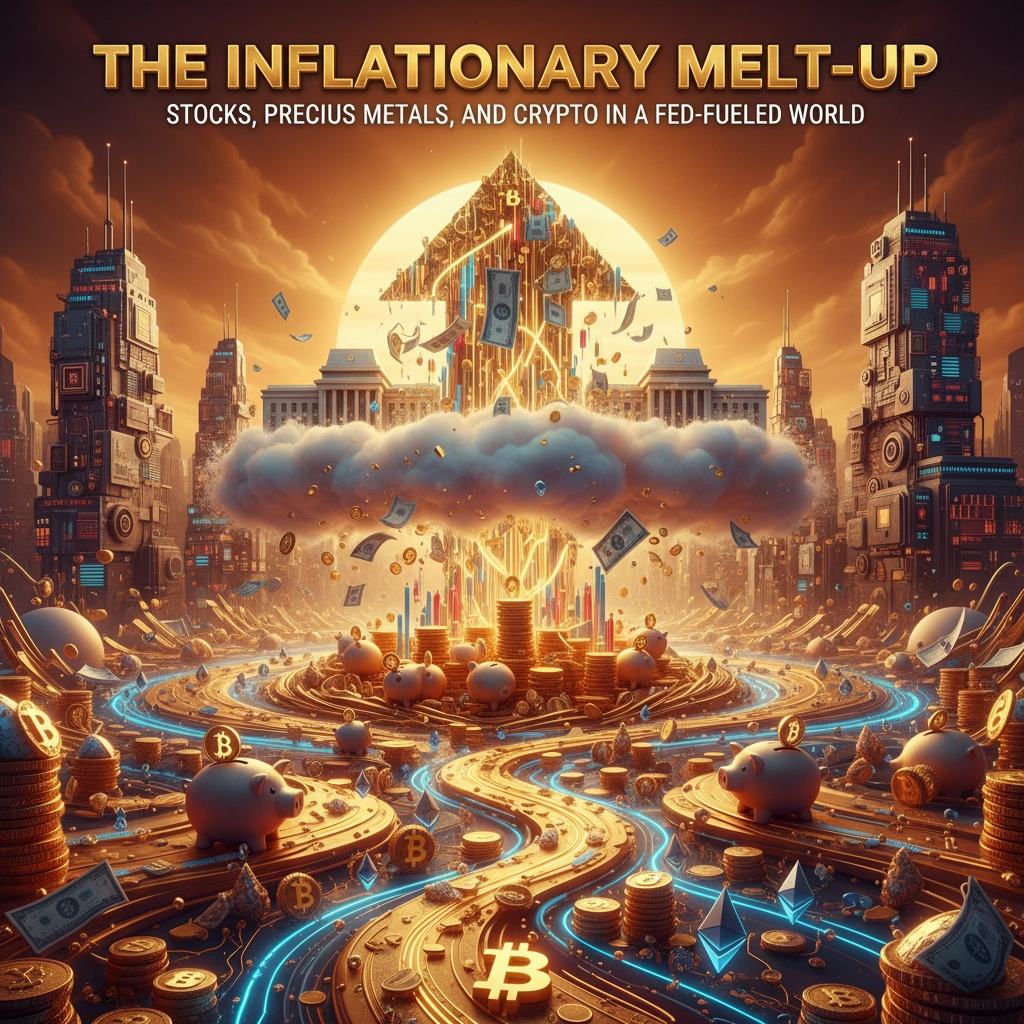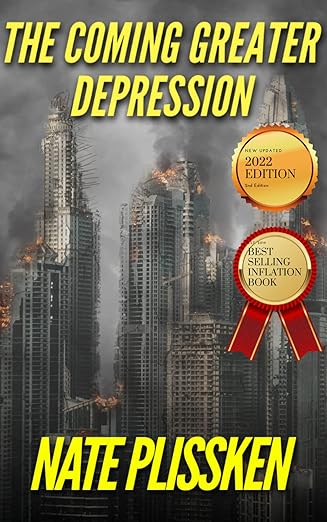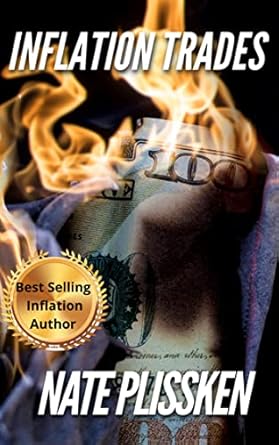
The Inflationary Melt-Up: Stocks, Precious Metals, and Crypto in a Fed-Fueled World

The Inflationary Melt-Up: Stocks, Precious Metals, and Crypto in a Fed-Fueled World. Look, we’re heading into one of the wildest financial periods most of us will ever see. The Federal Reserve has been playing with fire for years, and now we’re about to see the consequences play out across every major asset class. From stocks to gold to Bitcoin, everything’s about to go parabolic – but not for the reasons you might think.
What Exactly Is an Inflationary Melt-Up?
A melt-up isn’t your typical bull market. It’s when asset prices go completely insane, shooting up way beyond what makes any rational sense. Think of it as the financial equivalent of a sugar rush – everything feels amazing until you crash hard.
Here’s what makes it different: a regular bull market is driven by solid fundamentals, good earnings, economic growth. A melt-up? That’s pure emotion and fear of missing out. It’s when people throw caution to the wind and buy everything in sight because they’re terrified of being left behind.
As veteran macro strategist David Hunter puts it, “Investor psychology is the most powerful emotion in the world.” And right now, that psychology is priming us for the biggest melt-up in market history. Hunter’s predicting some jaw-dropping numbers: S&P 500 hitting 8,000, Nasdaq reaching 27,000, and gold approaching $4,000.
Sound crazy? Maybe. But when you understand what’s driving it, those numbers start looking a lot more possible.

The Fed’s Recipe for Financial Chaos
The Federal Reserve is basically cooking up the perfect storm for an inflationary melt-up. Every time they cut interest rates, they’re essentially printing money and weakening the dollar. It’s like watering down your whiskey – sure, you’ve got more liquid, but it’s not worth as much per ounce.
When rates go down, people flee from cash and bonds (which suddenly look pathetic) and pile into stocks, real estate, commodities, crypto – anything that might hold its value better than a depreciating dollar. It’s not that these assets are necessarily getting more valuable; it’s that the dollar is getting weaker.
Chairman Jerome Powell has been walking a tightrope, trying to manage inflation while keeping the economy from falling off a cliff. But here’s the thing – he’s in an impossible position. Cut rates too much, and inflation goes crazy. Keep them too high, and the economy tanks.
Recent Fed statements have been all over the map, trying to sound confident while clearly being worried about both inflation and recession. The market’s basically calling their bluff, betting that they’ll have to choose inflation over economic collapse when push comes to shove.
Why Stocks Are About to Go Nuts
The stock market during a melt-up isn’t about companies getting better – it’s about dollars getting worse. When the Fed floods the system with cheap money, that cash has to go somewhere. And with bond yields looking terrible and savings accounts paying basically nothing, stocks become the “least bad” option.
We’re already seeing signs of this. Despite economic uncertainty, stocks have been grinding higher, driven more by liquidity than actual business improvements. Companies with mediocre fundamentals are getting priced like they’re the next Apple. That’s melt-up behavior.
The scary part? Once this really gets going, even smart money gets pulled in. Nobody wants to be the guy who missed out on 50% gains because they were being “rational.” FOMO is a hell of a drug, especially when everyone around you is making money hand over fist.
Hunter’s prediction of S&P 500 at 8,000 sounds insane until you realize we’re already at historically high valuations. Add some currency debasement and investor mania, and suddenly it’s not that far-fetched.

Gold and Silver: The Old-School Inflation Hedge
Precious metals are like the canary in the coal mine for currency debasement. When people start losing faith in paper money, they run to gold and silver like their financial lives depend on it – because they often do.
Gold’s been on a tear lately, and it’s not because someone discovered a new use for it. It’s because people are waking up to the fact that central banks around the world are debasing their currencies. When the purchasing power of your dollars is declining, gold starts looking pretty attractive.
Silver’s even more interesting because it’s got both investment and industrial demand. During a melt-up, you get the double whammy of inflation hedge demand plus industrial needs from all the “green energy” initiatives governments are pushing.
Hunter’s long-term targets are mind-blowing: $20,000 gold and $500 silver. Those numbers sound impossible until you remember that these are just paper prices reflecting currency debasement. The metal isn’t getting more valuable – the money is getting less valuable.
Crypto: Digital Gold on Steroids
Bitcoin and other cryptocurrencies are basically turbo-charged versions of precious metals for the digital age. They’ve got the same appeal as gold – limited supply, no central bank control – but with the added benefit of being easily transferable and divisible.
When the Fed starts cutting rates aggressively, crypto benefits from the same currency debasement dynamics that help gold. But crypto also gets the tech premium and the millennial/Gen Z preference for digital assets over physical ones.
The beauty of Bitcoin during an inflationary period is that there will only ever be 21 million coins. No central banker can print more. No government can debase the supply. It’s like having a swiss bank account that governments can’t freeze or confiscate.
Other cryptocurrencies benefit too, but Bitcoin’s the one with the clearest “digital gold” narrative. As people lose faith in fiat currencies, Bitcoin becomes the obvious alternative store of value.

The Fed’s Impossible Position
Powell and the Federal Reserve are stuck between a rock and a hard place. They know that cutting rates too aggressively will fuel more inflation, but they also know that keeping rates high risks a major economic collapse.
Recent Fed communications have been trying to thread this needle, talking tough on inflation while leaving the door open for cuts if things get bad. The problem is that markets are forward-looking, and everyone knows the Fed will choose inflation over deflation when forced to pick.
As Hunter points out, Powell might initially try to be tough like Paul Volcker was in the early 1980s. But once financial contagion starts – bank failures, sovereign debt problems, corporate defaults – the Fed will panic and implement quantitative easing “on steroids.” We’re talking about potentially expanding their balance sheet to $30 trillion or more.
That’s when the real melt-up begins.

The Three-Phase Timeline
Here’s how this whole thing is likely to play out, according to Hunter’s analysis:
Phase 1 (Now through 2025): The Melt-Up
This is where we are now. FOMO drives everything higher as the Fed cuts rates and floods the system with liquidity. Stocks, gold, crypto – everything goes parabolic. It’s the greatest party in financial history.
Phase 2 (2027): The Crash
All that leverage and speculation comes home to roost. Hunter calls it “a bust that feels like a depression – probably bigger. Something like 2008-09 on steroids.” This is when overleveraged positions unwind and reality reasserts itself.
Phase 3 (2027 and beyond): The Reflationary Boom
After the crash, governments panic and implement massive stimulus programs. This creates the biggest commodity boom in history, with potential targets of $500 oil and $25 copper. This is when Hunter’s $20,000 gold and $500 silver targets come into play.

What This Means for You
Understanding this cycle is crucial for protecting and growing your wealth. The key insight is that we’re not just seeing normal market appreciation – we’re seeing currency debasement showing up as higher asset prices.
The winners will be those who position themselves in real assets before the melt-up really gets going. The losers will be those holding cash and bonds while the purchasing power of the dollar gets destroyed.
But here’s the catch – timing matters. Getting in early is great, but knowing when to get out is even more important. As Hunter warns, “This melt-up will be the largest in market history – but it’s the last one.”
The Psychology Behind the Madness
The most dangerous part of a melt-up isn’t the financial mechanics – it’s the psychological component. When asset prices start going parabolic, even conservative investors get pulled in by FOMO. Nobody wants to be the guy who was “too smart” to participate in the biggest wealth creation event of their lifetime.
This is exactly what makes melt-ups so dangerous. They create a feedback loop where rising prices justify even higher prices, and anyone who questions the logic gets dismissed as not understanding the “new paradigm.”
But there is no new paradigm. There’s just currency debasement, leverage, and human psychology playing out the same way they have for centuries.

Preparing for What’s Coming
The smart money isn’t trying to time the exact top or bottom. They’re positioning for the overall trend while maintaining enough flexibility to adapt as conditions change.
That means holding real assets that benefit from currency debasement: stocks (especially those with pricing power), precious metals, real estate, and potentially some cryptocurrency exposure. It also means avoiding long-term bonds and excessive cash positions.
But it also means being prepared for the eventual reversal. Melt-ups always end badly, and when they do, the correction is usually swift and severe. Having an exit strategy is just as important as having an entry strategy.
The Bottom Line
We’re entering a period where traditional investment wisdom might not apply. When currencies are being actively debased by central banks, the rules change. Assets that look expensive by historical standards might actually be cheap when priced in constantly depreciating dollars.
The inflationary melt-up isn’t just a possibility – it’s already starting. The only question is how high asset prices go before reality reasserts itself. Understanding this dynamic isn’t just about making money; it’s about preserving purchasing power in an environment where fiat currencies are under assault.
The ride’s going to be wild, but for those who understand what’s happening and position themselves accordingly, it could also be the wealth-building opportunity of a lifetime. Just remember – every melt-up eventually melts down. The key is being ready for both.
